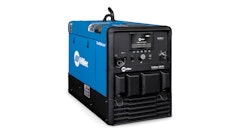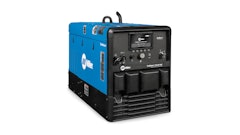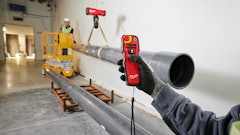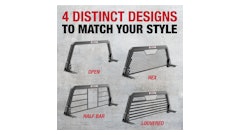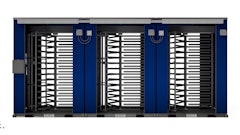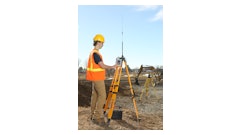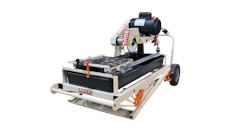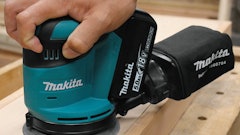With spring right around the corner, homeowners will be looking to clean up their yards. Gasoline-powered chainsaws cut and trim tree and shrub branches and are an excellent tool to help homeowners get rid of their debris. But these powerful tools operate at high engine speeds to propel the chain through a wood surface to make a quick cut. From the Outdoor Power Equipment Institute, here are some chainsaw safety tips:
Before using:
Protect yourself by wearing safety footwear, snug-fitting clothing, protective gloves, eye, hearing and head protection devices.
Carry the chainsaw with the engine stopped, the guide bar and saw chain to the rear, and the muffler away from your body.
Don't cut until you have a clear work area, secure footing, and a planned retreat path from the falling tree.
Be careful handling fuel. Move the chainsaw at least 10 feet from the fueling point before starting the engine.
Do not allow other people near the chainsaw when starting or cutting with it. Keep bystanders and animals out of the work area.
Make sure the saw chain is not contacting anything before starting the engine.
Check that the cutting area is free of obstructions. Don't let the nose of the guide bar contact a log, branch, or other obstruction that could be hit while you are operating the saw.
Do not operate a chainsaw that is damaged, improperly adjusted, or not completely and securely assembled. Make sure the saw chain stops moving when you release the throttle control trigger.
Do not operate when you are tired. Excessive vibration, noise, emissions, and uncomfortable positions could cause fatigue.
Understanding kickback:
Kickback can occur when the nose or tip of the guide bar touches an object or when the wood closes in and pinches the saw chain in the cut. Tip contact may cause a lightning-fast reverse reaction, kicking the guide bar up and back toward the operator.
Pinching the saw chain along the top of the guide bar can push the guide bar rapidly back toward the operator. Either of these reactions might cause you to lose control of the saw, which could result in serious personal injury.
Do not rely exclusively upon the safety devices built into your saw. As a chainsaw user, you should take several steps to keep your cutting jobs free from accident or injury.
Operate with caution
Reduce or eliminate the element of surprise by understanding how kickback happens.
Keep all body parts away from the saw chain when the engine is running.
Do not operate a chainsaw with one hand! Serious injury to the operator, helpers, bystanders or others can result from one-handed operation. Chainsaws are designed for two-handed use.
Keep a good, firm grip on the saw with both hands when the engine is running. Keep the right hand on the rear handle and the left hand on the front handle. Use a firm grip with thumbs and fingers encircling the chainsaw handles. A firm grip will help you reduce kickback and maintain control of the saw. Don't let go.
Cut at high engine speeds.
Don't overreach or cut above shoulder height.
Use extreme caution when cutting small-size brush and saplings because slender material can catch the saw chain and be whipped toward you or pull you off balance.
When cutting a limb that is under tension, be alert for springback so that you will not be struck when the tension in the wood fibers is released.
Keep the handles dry, clean and free of oil or fuel mixture.
Operate the chainsaw only in well-ventilated areas.
Do not operate a chainsaw in a tree unless you have been specifically trained to do so.
Shut off the engine before setting the chainsaw down.
What motivates people to do what they do?
Research shows people are motivated by six primary forces in their life. These factors have a major impact on how well and how satisfied a person will be in a particular job.
The Personal Interest Attitudes & Values report measures why people do what they do. It identifies the six workplace motivators common in all people. For example, the most successful salespeople fall within the Individualistic and Utilitarian motivators.
THEORETICAL: Drive for Knowledge
High: Shows a high degree of curiosity; appetite for learning; technical credibility.
Low: Wants to learn enough to be practical and get results; quick implementation of ideas.
UTILITARIAN: Drive for Money/Materials
High: Competitive, bottom-line orientation; wants practical solutions; hears the "revenue-clock."
Low: Enjoys helping others; puts others before self; service- or support-driven.
AESTHETIC: Drive for Form/Harmony
High: Feels most creative in a work environment that is pleasing to the eyes and spirit.
Low: Can get things done without pleasant surroundings; sees only the job task at hand.
SOCIAL: Drive to Help Others
High: Shows generosity in sharing their time and talent with others; a willing teacher and coach.
Low: Won't be taken advantage of; maintains a "business guard" on giving away talents.
INDIVIDUALISTIC: Drive for Influence/Power
High: Likes to take charge of projects; competitive; enjoys being a leader; will take the credit or blame.
Low: Very good team player; supports the project or cause; no hidden-agendas.
TRADITIONAL: Drive for Order and Structure
High: Well-disciplined, detailed problem-solver; high respect for rules, procedures and protocol.
Low: Very adaptable to new projects; sets new precedent; sees the big picture.
This report helps illuminate these motivating factors and attitudes and allows people to understand the driving forces behind their decisions and the jobs they are most happy in.
Look for the Personal Interests and Attitudes report at www.chartcourse.com/ttiassessments.html.
Creating repeat business
Follow these tips to help you receive high ratings from your customers.
Cater to your regulars. Your most frequent customers are your most valuable. They're the customers that have been with you for years, through thick and thin. Treat every customer you meet as a potential regular. Remember their names, faces and preferences.
Put your customers at ease. As a front-line service professional, you represent the company you work for, and it's your job to make customers feel comfortable. It's a simple formula: If you're comfortable with customers, they'll be comfortable with you.
Be flexible. While you might not be able to cater to a customer's every request, you can be flexible. Offer to meet with a customer who needs your help at his convenience or make an after-hours delivery if necessary.
Ask for feedback. When talking to customers, always take advantage of an opportunity to ask for feedback. While you might not be able to make any changes, you can pass their opinions on to those who can.
For more tips on cornering the market on service, visit Briefings Publishing Group at www.briefings.com.
Recruiting and retaining Gen X and Y employees
Does your organization rely on the younger generation for employees? Are some of your workers in their late teens, twenties, and early-to-mid thirties? If so, they're part of Generation Y (born in the 80s) or Generation X (those born between 1964-1982). Many employers would agree that both groups seem to be more motivated by personal fulfillment opportunities on the job than by traditional monetary rewards.
From The Navigator #76. Visit www.chartcourse.com.
Solicit complaints
If you rarely receive customer feedback, you're probably not looking hard enough. People who have had a bad experience often don't bother to complain; they simply vote with their feet and take their business elsewhere. To keep your customers talking to you, actively solicit complaints. Ask, "What mistakes have we made lately?" or "What would you like to see us improve?" www.briefings.com









